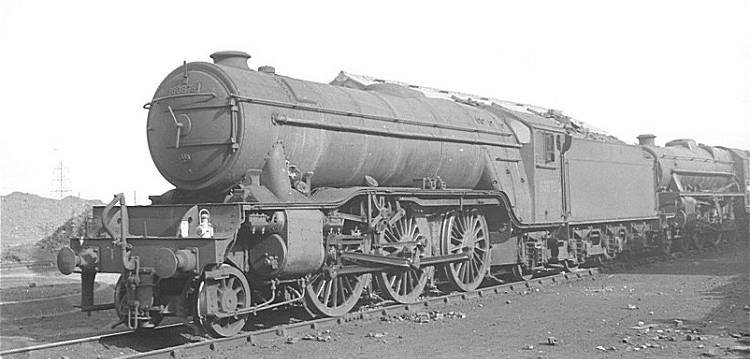- LNER Class V2
Infobox Locomotive
powertype=Steam
name = LNER Class V2
caption = 60876 on no.9 road at Annesley MPD,6 May 1962 .
designer =Sir Nigel Gresley
builder = LNER Doncaster and Darlington Works
builddate = 1936–1944
totalproduction = 184
whytetype =2-6-2
uicclass=1'C1'
gauge = RailGauge|ussg
leadingsize = 3 ft 2 inches
driversize = 6ft 2 inches
trailingsize = 3 ft 8 inches
axleload=convert|22|LT|t|1
length =
weight =
fueltype = Coal
fuelc
waterc
cylindercount = 3
cylindersize =
firearea =
boilerpressure = 220 psi
tractiveeffort = 33,730
railroadclass=LNER: V2 BR: 6MT
retiredate=1962–1966 TheLondon and North Eastern Railway (LNER) Class V22-6-2 steam locomotives were designed bySir Nigel Gresley for express mixed traffic work, and built between1936 –1944 . The best known is the first of the class, 4771 (later 800 and 60800) "Green Arrow", which is the only preserved example.Construction
The V2s were the only major class of
2-6-2 tender locomotives used in Britain. Whilst 2-6-2T tank locomotives were common in the UK, the only other 2-6-2 tender locomotives were the unsuccessful experimentalMidland Railway Paget locomotive of1908 , and the two examples of Gresley'sLNER Class V4 of 1941. The wheel arrangement allowed the fitting of a large firebox uninhibited by the rear driving wheel, and the front pony truck improved stability at high speeds.The V2 was derived from the Class A1/A3 pacifics with smaller
driving wheel s (of 6'2" compared to 6'8") and a shortened boiler. It retained Gresley's favoured 3-cylinder arrangement. Unusually all 3 cylinders were part of a single 'monobloc' casting.184 locomotives were built in 14 batches between
1936 and1944 at Doncaster and Darlington Works, construction continuing through theSecond World War as they proved their usefulness. A further four locomotives, ordered as V2s, were redesigned by Gresley's successor Edward Thompson and completed as Pacifics (LNER Thompson Class A2 ).These Gresley thoroughbreds had one drawback. They may have been 'do anything' engines but they were far from 'go anywhere' engines. With a 22 ton
axle load their use was restricted to around 40% of the LNER's route miles. For example, they were barred from all of the former Great Eastern Railway main lines. Gresley recognised that a lighter mixed-traffic locomotive was required, and the V4 class was designed to this end. However, it was to be the versatileLNER Thompson Class B1 4-6-0 which succeeded the V2 as the LNER's standard mixed traffic locomotive.Working life
First of the initial batch for five Doncaster-built V2s was number 4771, which emerged in June 1936 and was promptly named "Green Arrow", after the express freight service for which the locomotives had been built. Successful trails with this quintet led to both Doncaster and Darlington works producing further batches. The final locomotive, number 3695, was delivered from Darlington in July 1944.
The V2 had the free steaming qualities that the LNER's operating department required. Not only were they capable of working vacuum braked freights at up to 60mph, they could deputise for Pacifics on express passenger schedules. In peak condition a V2 could almost match the Pacifics for sustained high speed running. One locomotive was reliably timed at 93mph on the Yorkshire Pullman while another attained 101.5mph on a test train.
Whatever the V2s achieved before 1939 and after 1945 will always be eclipsed by their astonishing feats of haulage during World War Two. Trains of over 20 carriages loaded to 700 tons proved within their abilities. On at least one occasion a single V2 hauled 26 coaches from Peterborough to London. Given this capacity for work it was not surprising that construction was allowed to continue through the war years. When construction stopped in 1944 the class numbered 184 engines. They were the last Gresley designed engines to be produced.
The V2s performed equally competently for British Railways leaving their mark on the East Coast Main Line, the Waverley Route between Carlisle and Edinburgh and on the ex-Great Central main line between London Marylebone and Sheffield. Their swansong came on the Edinburgh - Aberdeen run, working alongside the last LNER A2s and A4s. The entire class was withdrawn from service between 1962 and 1966, having been displaced by diesel locomotives.
Names
Only eight V2s were named. The first of the class was named after the express freight train "Green Arrow". Five more were named after Regiments and two after
public school s. It is thought that more would have been named had the outbreak of war not intervened.Numbering
When built, the V2s were numbered 3641-3695 and 4771-4899. Under the
LNER 1946 renumbering scheme they were renumbered 800-983. After nationalisation in1948 ,British Railways added 60000 to their numbers so they became 60800-983. BR also gave them thepower classification 6MT.Preservation
One Class V2 survives. The first of the class 4771 "Green Arrow" has been preserved as part of the National Collection, and was in use on preserved lines around Britain. On 1st April 2008, it suffered a boiler failure on the
North Yorkshire Moors Railway . Since then the Engine has been stored, pending a return to the National Railway Museum. It's Boiler repairs have been determined as achievable, however the one task the NRM are not willing to tackle is the replacement of the 'monobloc' cylinder casting, a crack in which has deemed it scrap. It is unfortunate that 60800 was not one of the V2 that were modified to incorporate separate cylinder blocks, when a lot of the class were modified in the 1940's and 1950's.References
*
*
*
*
*
*External links
* [http://www.lner.info/locos/V/v2.shtml LNER encyclopedia]
* [http://www.railuk.co.uk/steam/getsteamclass.php?item=V2 Railuk database]
* [http://www.yorksteam.co.uk York Steam, Steam Locos - In York]
Wikimedia Foundation. 2010.
